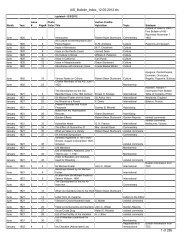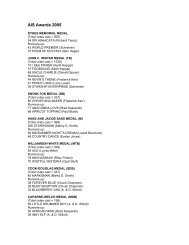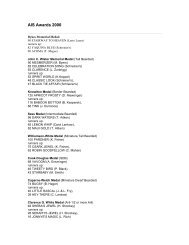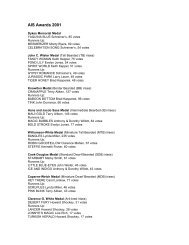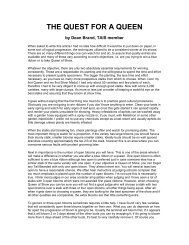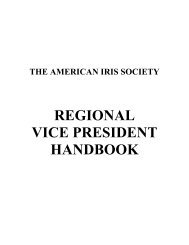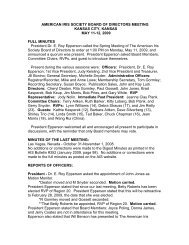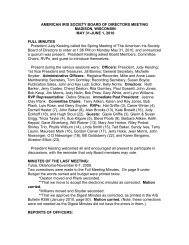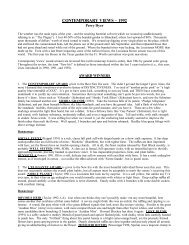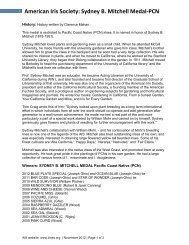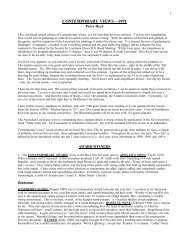contemporary views – 1988 award winners - American Iris Society
contemporary views – 1988 award winners - American Iris Society
contemporary views – 1988 award winners - American Iris Society
You also want an ePaper? Increase the reach of your titles
YUMPU automatically turns print PDFs into web optimized ePapers that Google loves.
overgrown in rich soil. BAY RUFFLES (Warburton 1985) is the best newer blue, a pure elegant sky blue with self<br />
beards. It has the classical form of ‘Azure Gem’, and I would like to see the results of a union of the two. I feel it has been<br />
overlooked thusfar.<br />
Another that is apparently being overlooked is DELICATE PINK (C. Palmer 1984), simply the finest pink SDB<br />
available. It is a wide soft baby pink the color of ‘Cherub Choir’ (Corlew, TB), with finished form and substance like<br />
leather. Unfortunately, we’ll never know the parentage, but the breeding potential is unlimited. In a class with so many<br />
good representatives as the yellows, a good new one must really have personality. HIGHBORN KINSMAN (Nichols<br />
1985) is a clean bright lemon to medium yellow in the tradition of ‘Merry Sunlight’ (B. Jones), with a deeper brilliant<br />
gold spot half-way down the falls, blending harmoniously into the principal color. Excellent form, with horizontal falls<br />
that are finely edged with picotee. Black 86253C is a stunning plicata in the tradition of ‘Auburn Valley’ (Willott), with<br />
cream ground distinctly banded in deepest wine to maroon.<br />
Black 86319B is the best improvement seen so far in the apricot class, a much improved ‘Melon Honey’ (Roberts),<br />
slightly deeper and better formed and substance. There is a hint of an orange spot around medium orange beards. It even<br />
has a touch of lace in the falls. 1 to 2 branches with up to 4 buds. [NOTE: This seedling was named PATACAKE,<br />
introduced in 1989]. SERENITY PRAYER (Dyer 1989) will be the last Dyer introduction for several years probably, as<br />
my own hybridizing endeavors are currently taking a vacation for a few years! From some extensive work for blue-bearded<br />
whites, it is actually a glowing cream with undertones of soft butter yellow and a mother-of-pearl sheen. Then, an intense,<br />
quite clean azure blue to indigo beard produces a nice contrast. A very stately, elegant median.<br />
CLASSICS: COTTON BLOSSOM (B. Jones 1970); ROYAL CARNIVAL (C. Palmer 1974); SAPPHIRE GEM<br />
(Schmelzer 1975); AXIOM (Hager 1977); COMBO (Hager 1977).<br />
LOUISIANAS<br />
I may have lost most of my bearded irises in the floods during June 1987, but the Louisianas loved it! Bayou North had<br />
the best bloom ever, and I took several stalks to both the Oklahoma City and Tulsa shows when they were at peak. Only<br />
a true iris lover (nut?) would lug 30 stalks in the back of a little Chevy S-10 King Cab pickup 130 miles to a show!<br />
The Bertinot bed went bananas. Increase was intense, and 3’ tall show stalks abounded. The star was BELLEVUE’S<br />
COQUETTE (1985), a simply glorious, sparkling light blue from ‘Clara Goula’ in the general color range of the TBs<br />
‘Loyal Devotion’ or ‘Tide’s In’. It does have lavender undertones, but the effect was very blue. Broad, flat form with<br />
moderate ruffling inherited from Clara. Consistently opened 3 at once <strong>–</strong> even on the day of the show! BELLEVUE’S<br />
ANGELA (1984), BELLEVUE BEAUTY (1985), and BELLEVUE BUTTERFLY (1984) are also all from ‘Clara<br />
Goula’ and are all in the same general color range of cream to light yellow. Yet each is distinctive enough to have merited<br />
introduction. This year the best was ‘Bellevue’s Angela’, with the tallest, strongest stalks and the widest, most airy form.<br />
BELLEVUE’S MICHELLE (1983) was Neil’s first introduction, and is still one of his best. Pure elegance in a mauvelavender<br />
bitone effect (an improved ‘Charlie’s Michele’ (Arny), with brighter tones) and even heavier ruffling than those<br />
listed above. Yes, again, a child of ‘Clara Goula’. The most popular, and my favorite second only to ‘Bellevue’s<br />
Coquette’, was JERI (1985). From ‘Full Eclipse’ (Hager), the saturation is not as deep a black, but the flowers are larger<br />
and open properly to full-blown size. Stunning in the garden. It was in full bloom on May 14, when I cut 2 stalks for the<br />
shows. It finally finished blooming on May 31, the last iris to close at Contemporary Gardens. Now that is excellent<br />
sequence of bloom!<br />
VALERA (Arny 1980) is still a favorite, an absolute nonfading self in tones remindful of creamed coffee <strong>–</strong> about the color<br />
of the TB, ‘Coffee House’. I have yet to see another Louisiana like it. Superb show stalks too, often opening 3 blooms<br />
simultaneously. BOLD COPY (Rowland 1983) and BOLD PRETENDER (Morgan 1984), both from ‘Miss Arkansas’<br />
(Chowning) <strong>–</strong> and therefore kin to ‘Ann Chowning’ (Chowning) <strong>–</strong> are fine reds. ‘Bold Copy’ was a little shorter, with a<br />
brighter, more cherry red with huge ‘Ann Chowning’ yellow signals. ‘Bold Pretender’ was a bit taller, with more of a<br />
dulled red and smaller, more diffused yellow signals. DELTA DAWN (Dunn 1983) is still my favorite of the Dunn<br />
varieties, with soft, elegant blended sunrise colors of peach, tan, orange, and rose-pink. MARY’S CHARLIE (Dunn<br />
1982) comes next, with the most vibrant magenta tones in the species. Tall and finely ruffled.<br />
E.C. EVERINGHAM (Raabe 1980) remains the most overlooked Louisiana of this decade. Although this glowing,<br />
broad violet received an HM, it deserves much more. SINFONIETTA (Raabe 1987) was the best ever, with smaller baby<br />
blue flowers with even truer blue tones than the classic ‘Eolian’ (Arny). It made up for the disappointing debut here of<br />
BYRON BAY (Raabe 1986). Two others from Australia bloomed for their first time here, and were most impressive:<br />
SUMMER MINSTREL (Raabe 1986) is a difficult color to describe, with amber-russet tones blended with undertones of<br />
14



